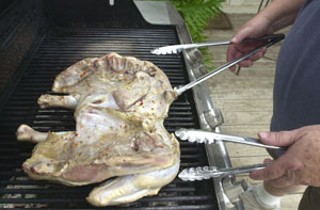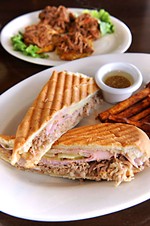Spatchcocking!
I will be your guide and translator as we cover what is sure to be a revolution in turkey preparation
By Mick Vann, Fri., Nov. 17, 2006
Those Thai birds were spatchcocked, a British butchery term that came into use in the 1700s and referring to the removal of the backbone of a bird so that it can be flattened prior to grilling over coals. Capt. F. Grose, in his 1785 Dictionary of the Vulgar Tongue, describes the term thusly: "Spatch cock, abbreviation of a dispatch cock, an Irish dish upon any sudden occasion. It is a hen just killed from the roost, or yard, and immediately skinned, split, and broiled."
Once I grilled the first prototype, it occurred to me that the dynamics of the process cause all portions of the bird to cook evenly. Instead of a huge breast towering above the rest of the turkey, with that portion being the leanest (and driest) part of the bird, it is now safely protected by the much fattier thighs and wings on the outside and is on the same level as the rest of the carcass. It is a form that marries well with marinating, a flat rectangle being much easier to marinate than a large football-shaped object. Trying to determine the estimated cooking time was a crapshoot: I had no clue as to how long it would take but knew that it would be considerably shorter than roasting in an oven.
With that first 12-lb. bird sizzling comfortably on a friend's grill, we began to scientifically test the temperature with an instant-read thermometer every 15 minutes, looking for that magical 150-degree reading (the bird will continue to cook slightly as it rests for the required 10 minutes before slicing). The first one we grilled turned out to be perfectly done in one hour and 10 minutes. The next one took five minutes longer, but the grill was funkier and less controllable. The third one took one hour and 15 minutes. Our 14-pounder, which had a thicker breast, took one hour and 25 minutes. A cooking-timing standard had been established.
The Feds recommend a temperature of 185 degrees to be completely safe. This also guarantees a bird devoid of any moisture, which ensures radically increased gravy consumption out of sheer culinary self-defense. At 145 degrees, the juices from the thickest part of the thigh will run clear (i.e., not pink) when pierced, which used to be the doneness standard before the advent of digital thermometers. I've found that an internal temperature of 150 degrees will insure a tender, moist bird with no trace of pinkness.
This method of turkey cooking is loaded with advantages.
Time: Grilling a spatchcocked turkey is the fastest way to cook the bird. Frying only takes three minutes per pound, but it requires about an hour just to get the oil hot enough to cook the thing. Conventional roasting can take as long as four hours, and smoking a turkey will gobble up eight to 12 hours.
Space: Thanksgiving is all about the oven. So much successive baking – pies, cakes, cookies, and oodles of casseroles – is done in ovens that can be stretched to their limits by a large cookie sheet of Tater Tots. Everyone has to compete for valuable oven real estate, and having a huge turkey in there just compounds the problem. Usually the top rack has to be removed to get the bird in the oven, so all other baking chores grind to a halt for the next 21/2 to three hours. Consider also that it's usually in the 80s around Thanksgiving in Central Texas, so having the oven on while cooking a bird for hours can really heat up the house.
Safety: Roasting a stuffed turkey with a cavity full of raw dressing can allow the stuffing and the surrounding meat to sit at the microbial danger zone for too long, and it further increases the cooking time by an hour or so. Consider the Cajun alternative of a huge 60-quart vat of boiling oil with a flammable gas fire roaring underneath it, and you begin to wonder why even more houses aren't burned to the ground every Turkey Day and why more third-degree grease burns aren't reported at hospital ERs all over the South. (Not to mention the problem of dealing with 4 to 5 gallons of contaminated frying oil the next day; it's no surprise that city sewage clogs spike the day after Thanksgiving as thousands of gallons of grease congeal in sewer lines like so many arterial blockages.) Even worse, once it's fried, the turkey's skin and wings are black and inedible.
Social: Normally, the menfolk are huddled around the TV, beers in hands, watching successions of pregames, games, or postgames, while they ignore their families and get wasted. Fewer people in the kitchen are needed, not more, and fewer sloths lounging about underfoot would be a relief for that congestion. What could be better than a herd of guys in their natural element, hovering over a grill and a bed of coals, watching a big, flat bird slowly turning golden brown. The grilled turkey frees up oven space, eliminates the danger of nasty bacterial growth and boiling oil, and the guys are outside, actively involved in the cooking and not underfoot.
Taste: Every person I've spoken with who has eaten the now-famous grilled spatchcocked turkey has said that it is the juiciest and most flavorful turkey they have eaten. I heartily agree.
Here's how to do it:

1) You want a thawed 12- to 14-lb. turkey, with the wing tips and the backbone removed. You can always get your butcher to take the backbone out, or use a hefty pair of poultry shears, a thick-bladed knife, a bone saw, or a clean Sawzall. Once it's spatchcocked, press it as flat as you can: the flatter the better. It will resemble a large rectangle and will fit into a trash bag for storing until grilling time. Store it skin-side down so that the cut ribs don't pierce the plastic bag.

2) At this point, you can marinate the bird or apply a spice rub. A simple garlicky vinaigrette with such herbs as parsley, chervil, thyme, or a bit or tarragon or sage works nicely, as does a bottle of doctored-up zesty Italian salad dressing, for that matter. If you use a rub, use one that has little sugar in it because the sugar will caramelize too darkly on the grill. I've used marinades, rubs, and nothing but salt and pepper, and all three versions are excellent. If you expect a crowd, cooking two small turkeys will work out better than one large one.

3) Preheat your covered grill to medium-low; you will cook the turkey covered. You'll need two sets of long-handled tongs to flip this bad boy, which you will do every 15 minutes during the cooking process. Have a cooking thermometer handy so that you can start checking the internal temperature after about an hour and 10 minutes. You want to insert the thermometer probe into the thickest part of the thigh and the breast, without hitting any bone, for an accurate reading. Once it's at 150 degrees, take it inside, cover it with a piece of foil, and let it rest for 10 minutes before you start carving. Total elapsed grilling time: one hour and 15 minutes, give or take.

4) Before you grill, while you're waiting to grill, or during the actual grilling, you can make the gravy. You're going to use the turkey back and wing tips that you have removed, the giblets, and the neck that comes in the carcass (reserving the liver). Add a few smashed cloves of garlic, some onion trimmings, a celery rib, a carrot, a bay leaf, a few sage leaves, some thyme and parsley, salt, and pepper.
Cover with water and bring to a boil, simmering for one hour or longer, reducing it down to a pint and a half or so. If you really want to richen the flavor – and you should – go to MT Asian Market and buy a styro tray of duck or chicken feet to add to the mix. Most markets will be selling turkey necks, which can substitute nicely for the feet. Boil an egg, and mince it. Skim the fat from the top of the stock, and reserve. Whisk together the fat with equal amounts of flour to make a light roux, and reserve (using added butter if there is not enough fat). Pour the stock through a sieve, reserving the giblets. Finely mince the giblets, and add back in. Add the liver, simmer for 10 minutes, dice, and add back in. (Note: I'm not much of an organ or filter eater, so I eliminate adding the giblets and liver.)
Bring the strained stock to a boil, and whisk in the roux mixture in small amounts. Thicken to a gravylike consistency. Add the minced hard-boiled egg, and pull off any bits of meat from the neck and throw them in as well. Season with salt and pepper. Add to the gravy mixture any juices that run off of the turkey as it rests. Makes about a pint and a half.
For this photo shoot we convened a group of friends at the Chris and Diane Winslow ranch southwest of town. Robert Abraham, he of the legendary appetite, arrived with numerous bottles of appropriate wines. Friends Dave and Nancy Crowell showed up with a couple of loaves of crusty and moist home-baked bread, some gorgeous skewers of vegetables to be grilled with a lemon-garlic dressing, a wonderful microgreens salad, and a couple six-packs of Blue Paddle Pilsner. I grilled the turkey, made a batch of turkey and duck-foot gravy, and assembled a spicy Hatch green chile, pork, and posole stew.
Diane outdid herself by making a citrus-flavored mélange of sweet potato, stuffed and baked inside individual orange shells, and topped with a caramelized pecan topping. Havalah and baby Violet Winslow, with beau Christian, contributed a delectable baked stuffing made with half bread and half corn bread, accented with apples. Nancy Barnes, Diane's mom, arrived with two desserts: a rich chocolate fudge turtle cake and delicious cookie bars made of a shortbread crust, lime curd, and white-chocolate-macadamia topping. Chronicle photographer John Anderson, with significant other Caroline, arrived and commenced to take dozens of shots. Chris mowed the yard and kept the dogs (and the crowd) entertained.
The dinner was remarkable. All of the components jelled into a perfect whole, with each element being scrumptious. The centerpiece, the spatchcocked and grilled free-range turkey, was declared wonderful by all in attendance. We ate until we couldn't eat anymore, and Robert outdid himself in living up to his reputation with a four-plate performance. ![]()








